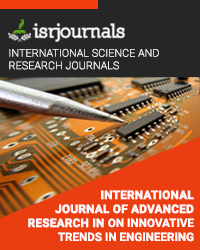modelling and simulation of multi input dc-dc converter for integrated renewable energy generated system using fuzzy controller.
Umesha S R,Shri Harsha J.,Capt. L Sanjeev Kumar,Madhu K.
Published in International Journal of Advanced Research in Electrical and Electronics Engineering
ISSN: 2321-4775 Impact Factor:1.6 Volume:3 Issue:2 Year: 14 February,2016 Pages:84-90

Abstract
The objective of this paper is to propose a Multi-input power converter for the hybrid system in order to simplify the power system and reduce the cost. Renewable energy technologies offers clean, abundant energy gathered from self-renewing resources such as the sun, wind etc. As the power demand increases, power failure also increases. So, renewable energy sources can be used to provide constant loads. A new converter topology for hybrid wind/photovoltaic energy system is proposed. Hybridizing solar and wind power sources provide a realistic form of power generation. The topology uses a fusion of Buck converters. This configuration allows the two sources to supply the load separately or simultaneously depending on the availability of the energy sources. Simulation is carried out in MATLAB/ SIMULINK software and the results of the Buck converter and the hybridized converter are presented.
Kewords
Renewable energy, Buck converter,Fuzzy controller,
Reference
[1] J. L. Duarte, M. Hendrix, and M. G. Simoes, “Three-port bidirectional converter for hybrid fuel cell systems,” IEEE Trans. Power Electron., vol. 22, No. 2, Mar. 2007. [2] K. Rajashekara, “Hybrid fuel-cell strategies for clean power generation,” IEEE Trans. Ind. Appl., vol. 41, No. 3,June 2008. [3] F. Valenciaga and P. F. Puleston, "Supervisor control for a stand-alone hybrid generation system using wind and photovoltaic energy," IEEE Trans. Energy Conversion, vol. 20, June 2009. [4] J. M. Carrasco, L. G. Franquelo, J. T. Bialasiewicz, E. Galvan, R. C. PortilloGuisado, M. A. M. Prats, J. I. Leon, and N.Moreno-Alfonso, “Power-electronic systems for the grid integration of renewable energy sources: A survey,” IEEE Trans. Ind. Electron., vol. 53, No. 4, June . 2009. [5] K. N. Reddy and V. Agrawal, “Utility-interactive hybrid distributed generation scheme with compensation feature,” IEEE Trans. Energy Convers., vol. 22, No. 3, Sep. 2010. [6] H. Tao, J. L. Duarte, and M. A.M. Hendrix, “Three-port triple-half-bridge bidirectional converter with zero-voltage switching,” IEEE Trans. Power Electron., vol. 23, No. 2, Mar. 2010. [7] O. C. Onara,M. Uzunoglu, andM. S. Alam, “Modeling, control and simulation of an autonomous wind turbine/photovoltaic/fuel cell/ultra capacitor hybrid power system,” J. Power Sources., vol. 185, No. 2, Apr.2011. [8] A. Khaligh, J. Cao, and Y. J. Lee, “A multiple-input DC–DC converter topology,” IEEE Trans. Power Electron., vol. 24, no. 3, Mar. 2011. [9] S. H. Hosseini, S. Danyali, F. Nejabatkhah, and S. A. K. Mozafari Niapour, “Multi-input DC boost converter for grid connected hybrid PV/FC/battery power system,” in Proc. IEEE Elect. Power Energy Conf., 2012 [10] R. J. Wai, Ch. Y. Lin, J. J. Liaw, and Y. R. Chang, “Newly designed ZVS multi-input converter,” IEEE Trans. Ind. Electron., vol. 58, No. 2, Feb. 2013 [11] Farzam Nejabatkhah, Saeed Danyali, Seyed Hossein Hosseini,Mehran Sabahi, and Seyedabdolkhalegh Mozaffari Niapour, “Modeling and Control of a New Three-Input DC–DCBoost Converter for Hybrid PV/FC/Battery Power System” IEEE Trans . Power Electron., vol.27, NO. 5, May 2013.

